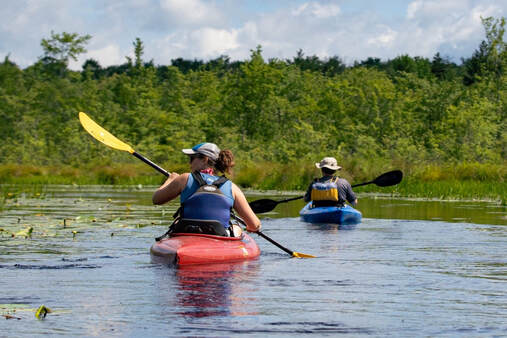|
A way to stay cool, safe and socially-distanced while having fun outdoors! Welcome to the hottest days of the year (so far). It’s obviously been a very odd summer due to the current circumstances, but amidst all the caution, confusion, and fear, people are turning to the outdoors to seek solace and relieve their restlessness. Our state park beaches and campgrounds are busier than ever before, and our National Recreation Area along the Delaware River has been packed with people every single weekend of the summer, to the point where parking lots are full by 10am on a nice day! It could not be clearer that in a time of crisis, when people are limited from gathering in indoor public spaces and travelling away for long vacations, our local natural resources and open spaces are needed now more than ever! Spending time outside in nature is one of the healthiest activity options right now. It’s been proven that sunlight (UV light) is capable of killing coronaviruses very quickly. Additionally, being outside means being away from recirculating air that could hold virus particles for several hours, and of course away from close contact with people in contained spaces. As spring turned to summer, many folks have turned to hiking on our numerous local trails to get outside while maintaining social distancing. However, passing people on tight forest trails isn’t ideal, and for that reason you should still carry a mask to use when on busy trails and in busy parking lots. But there is another activity to consider for a truly wide-open, socially-distanced experience in nature: paddling! Paddling is a wonderful hobby and recreational endeavor – however, you need to be aware of the risks and be comfortable out on the water. It’s also best to have your own equipment, which gives you the freedom to paddle wherever, whenever (rather than rely on renting from paddling outfitters, which were closed for the first few months of the pandemic). The equipment you’ll need is a boat (kayak or canoe – will you mostly be in a boat by yourself or do you want to take out a partner?), an appropriate paddle, a type III personal flotation device (PFD or “life jacket”), and a safety whistle. For those wishing to utilize state-owned boat launches, an annual $12 launch permit from PA Fish & Boat Commission is also required. Other accessories to consider are a drybag (for things you don’t want getting wet), bilge pump (to help pump out any water from the boat in case it gets swamped), and spray skirt (covers the whole cockpit and goes around your waist to seal out any splashes from getting in). If you’re completely new to the paddling scene, it’s recommended to start out by perhaps borrowing a canoe or kayak from a friend. Even better if they can take you out for your first time and teach you the basics. As stated before, there are also some outdoor outfitters that rent out kayaks and canoes and can help provide transport as well. It doesn’t cost much, but keep in mind they are there to facilitate the logistics of your adventure, not to provide guided instruction (which may be an option if you choose to pay for it). You can also find group paddling tours and even paddling classes – just look up local nature centers, state parks, or local canoe/kayak clubs to see when they might be offering a paddling program. If you want to have a great time and remain comfortable, it’s essential that you prepare for your outing and wear the right clothing. Paddling is a watersport, so yes, you will more than likely get wet! (Isn’t that kind of the point?!) Wearing swimwear and neoprene/synthetic materials is much better than wearing cotton clothing. Cotton can be deadly when on the water: when it gets wet, it ceases to insulate because the air pockets of the fabric fill up with water, which can lead to hypothermic situations. Fleece or wool is a much more effective insulating material when wet. A hat that shields the sun is important too (you’ll appreciate that more after your first scalp sunburn – ouch), as well as polarized sunglasses to protect your eyes from the blazing sun and get better visibility into the water. Once the weather cools off a bit, invest in a splash jacket or rain jacket and pants to keep the water from saturating you. Other items to think about would be plenty of water, snacks, sunscreen, lip balm, sunglasses strap, first aid kit, waterproof watch, and a headlamp (in case you’re having too much fun and don’t get back before dusk). Before you get out on the water, make sure you will be comfortable and stable by adjusting yourself to your boat. For kayaks, you may want the seat to recline a little bit for comfort (keep in mind not all boat outfitting allows for this), but for the best balance and power, you want to sit upright. If the boat has foot-pegs, adjust them so that your feet can rest against them with a slight bend in your knees. For the best stability, have your knees making contact with either side of the cockpit. Take this time to adjust your kayak paddle too. Many two-piece paddles can be adjusted to be shorter or longer, depending on the paddler’s height and the width of the boat. For beginners, start with both blades of the paddle being at a flat, even angle with one another. As you begin to paddle more, you may find that you are more comfortable with the paddle at an offset angle. This requires that your non-dominant wrist has to swivel around the shaft as you go back and forth with your paddling strokes so that the full face of the paddle blade is used to propel you in the water with each stroke. Kayaking with an offset-angled (or “feathered”) paddle is better for windy conditions because as one blade of the kayak is in the water, the other blade in the air sits at an angle to slice through the wind. Remember, don’t over-grip your paddle or you will tire out your hands quickly. For canoes, there’s no adjustments really. You just sit on the seat, both facing forward. Sorry, no back rest. Decide if your partner would rather sit in the back and do the steering, or sit in the front and be the muscle. The front person in the canoe typically uses a shorter single-blade paddle, while the person in back gets a longer single-blade paddle so that they can utilize steering strokes like the J-stroke, draw, pry, and ruddering. Be sure to switch sides as needed to balance out your hard-working arm muscles, although a lot of the power strokes come from using your core muscles instead. Canoes also require partner coordination too, which makes them a great team-building experience. With both canoes and kayaks, some practice getting in and out, as well as launching, is a very good idea. Set your boat into the water perpendicular to shore (unless you have a very long kayak or are launching into a river, then a parallel launch might work better). Straddle the cockpit and carefully sit down on the seat, then lift your legs and slide your feet into the cockpit. Also check your PFD is tight enough! A loose life preserver that slips off or floats up under your chin while in the water won’t be effective or comfortable. In most locations and situations, the law only requires that you have a PFD in the boat with you, but it’s highly suggested to just wear it the whole time. That PFD, even when wet, is a great insulator if you’re feeling chilly. If you get hot, remove a layer under the PFD and not just the PFD. PFDs make it fun and easy to float around while swimming too. Finally, some on-the-water tips!
Living in Pennsylvania, we are very fortunate to have all these paddling opportunities, not just locally but all across the state! The Pocono region especially has exceptionally pristine waterways, thanks to the efforts of many people and organizations ensuring they stay beautiful, healthy and unpolluted… because it wasn’t always this way. So this summer, we encourage you to adventure out, escape the chaos, and explore our local waterbodies in a safe way! -Brittney Coleman, Environmental Educator
1 Comment
1/14/2023 08:53:30 am
I was captured when you discussed that the boat must be set into the water perpendicular to shore. My friend wants us to try Delaware canoeing. I think it's a perfect way to relax so I'll join him.
Reply
Your comment will be posted after it is approved.
Leave a Reply. |
Archives
July 2020
Categories |
|
|
8050 Running Valley Road
Stroudsburg, PA 18360
Stroudsburg, PA 18360
|
|
|


 RSS Feed
RSS Feed




